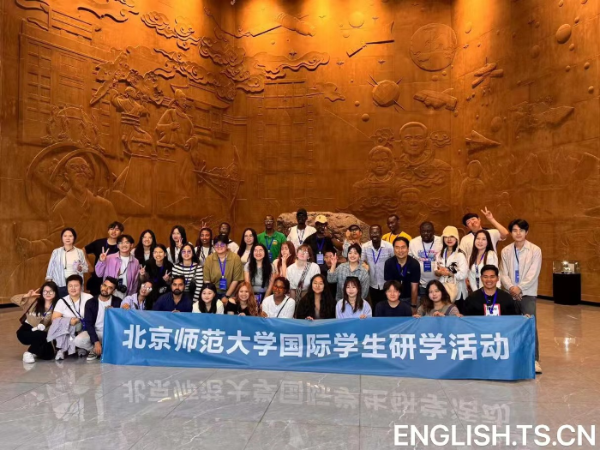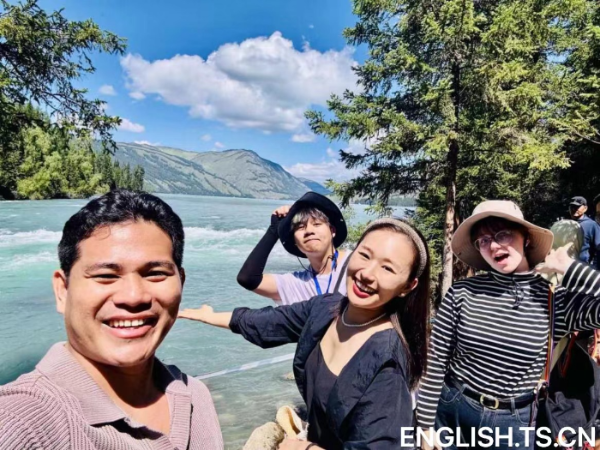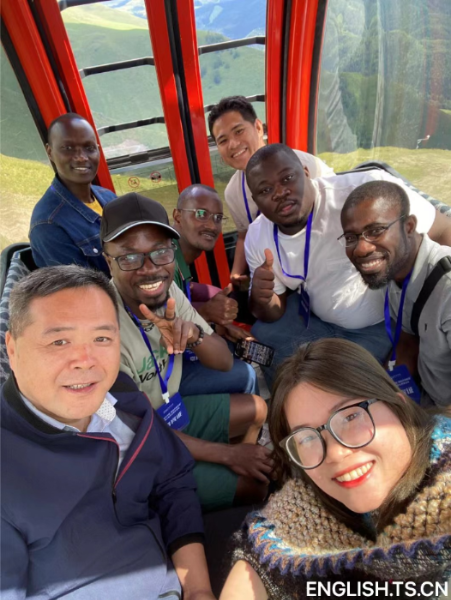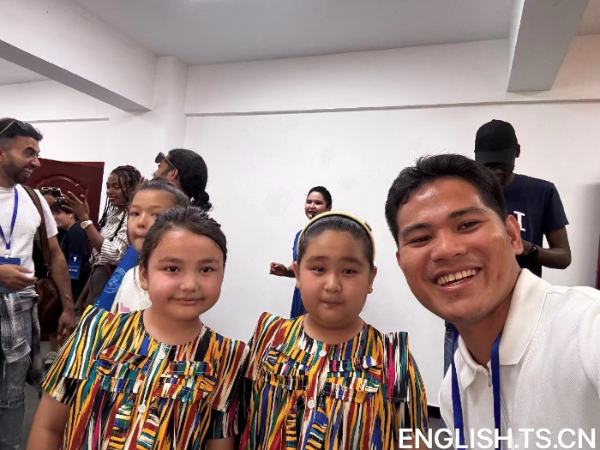Over 40 international students from more than 25 countries embarked on a nine-day journey through Xinjiang, China, from July 17 to 25. Organized by Beijing Normal University in collaboration with the Xinjiang government, this research activity took participants to diverse locations, including Urumqi, Shihezi, Karamay, and Altay. The initiative deepens students' understanding of contemporary China and the region's openness while they comprehensively explore Xinjiang's cultural, historical, ideological, and economic landscape of diversity.

Nilo Jayoma Castulo and other international students from Beijing Normal University take part in a nine-day journey through Xinjiang, China.
Out of the 40 international students, I was one—a Filipino shaped by a Western-dominated ideology that casts Xinjiang in a negative light. The Western media's portrayal has led many of us to view Xinjiang primarily through the lens of human rights and the freedom of religious belief issues. However, I encountered a different reality during our initial visit to Urumqi. The people there did not appear to be victims of oppression; instead, they were hospitable, smiling, welcoming, and warm.

Nilo Jayoma Castulo and his schoolmates watch an ethnic dance performance in Altay, northwest China’s Xinjiang Uygur Autonomous Region.
Another common stereotype about Xinjiang concerns the ethnicity of its people. Contrary to this misconception, Xinjiang is remarkably diverse, home to Han, Uygur, Kazak, Hui, Kirgiz, Mongols, and many other ethnic groups. While in Altay, I had the pleasure of meeting a local gathering wild strawberries near the rivers and mountains. With a warm smile, she presented the strawberries and generously offered us a taste. Not only did she answer our questions, but she also guided us on how to harvest strawberries. This action exemplifies the people's willingness to accept people from backgrounds that differ from their own.

Nilo Jayoma Castulo and his schoolmates take a selfie with the beautiful scenery of Xinjiang.
Xinjiang's stunning landscapes are often hidden from many, but they are truly breathtaking. The region boasts diverse scenery, including deserts, mountains, lakes, and canyons. Kanas Lake particularly captivated our hearts with its harmonious waves, vibrant green clear water, and the sight of birds flying freely as people watched in awe.
In addition, Xinjiang boasts lush pastures that are ideal for raising animals such as cows, camels, goats, and sheep. The region promotes sustainability by using solar panels and windmills to generate energy. The integration of technology into farming practices further enhances sustainability. Farmers are digitally educated and employ drones and advanced farming strategies to produce high-quality cotton, fruits, and other crops. Xinjiang's geographic location ensures ample sunlight, contributing to their peaches' deliciously sweetness and flavorful taste.
Contrary to claims that Xinjiang people lack the freedom of religious belief, my experience there revealed a different reality. Xinjiang exemplifies unity in diversity, with various religious beliefs—Islam, Christianity, and Buddhism—coexisting peacefully. I noticed the harmonious coexistence among people who live together in unity and peace despite their differences. This picture is a testament to freedom and mutual respect there.
In addition to its diverse population, Xinjiang is home to China's first oil field. The region's inhabitants benefit from the wealth generated by their land. During our visit to Karamay, I observed the oil production process firsthand and witnessed how this resource is extracted and managed. With abundant oil reserves, Xinjiang is referred to as the "Little Saudi" within China. Moreover, Xinjiang serves as a crucial corridor for the Silk Road, facilitating trade between Asia and Europe, and it also hosts a burgeoning car manufacturing industry among other economic activities.

Nilo Jayoma Castulo and some other international students take a photo with a government representative in Xinjiang.
At the Jikepulin International Ski Resort, we were joined by a Xinjiang government representative (the man wearing a dark blue jacket next to the lady in the photo), fostering a sense of closeness rather than distance. This approach reflects China's "people first" ideology, where leaders act as representatives and listeners to diverse voices, bridging the gap between the government and the people. Throughout our journey, in every city and place we visited, local leaders warmly welcomed us and saw us off at the borders, ensuring our safety. This experience highlighted Xinjiang's values, which are emblematic of Chinese values as a whole.
The journey of Xuanzang in the western region of China, which is now known as Xinjiang, made him realize the diversity of China. Before coming to China, I used to describe a Chinese person as having thin eyes, light skin, and a slim build. However, coming to Xinjiang made me realize that it is difficult to generalize the appearance of Chinese people due to their diversity. Chinese people, like any other group, come in various physical appearances. They can have different eye shapes, skin tones, and body types.

Nilo Jayoma Castulo takes photos with local ethnic children.
My journey to Xinjiang has led me to define Chinese identity as multi-ethnic, multilingual, and profoundly diverse, with immense beauty rooted in hard work and perseverance that have shaped a rich history. Despite many ethnicities, Chinese people are known for their adaptability, resilience, and strong family orientation. They take pride in their cultural heritage, and preserve their traditions even amidst a rapidly changing society.
As a Filipino, I realize that my perspective on Xinjiang reflects my view of the Philippines. Like China’s Xinjiang, the Philippines is incredibly diverse, with over 7,000 islands hosting various ethnicities, cultures, religious beliefs, and economic conditions. Xinjiang offers valuable insights into how a region can progress despite its diversity, making it an excellent case study for fostering unity and development in a diverse nation.
Observing Xinjiang has helped me appreciate that diversity is both a strength and a challenge for unity. The laughter of the people is the result of their struggles and achievements. Witnessing Xinjiang's journey towards peace, prosperity, and openness has made me confident that conflicts arising from diversity can be managed by embracing differences and striving for diplomacy to achieve peaceful coexistence. Reflecting on my trip to Xinjiang, I find that this perspective helps deconstruct stereotypes and negativity about the region. It is a journey of beautiful awakening, not just for me but also for the other 40 international students trained to be teachers and leaders in the education sector in their country. Wonderful Xinjiang! I Love Xinjiang, and it is more fun in Xinjiang.
Nilo Jayoma Castulo is a PhD Candidate at the Institute of International and Comparative Education, Beijing Normal University.
Producer: Xiao Chunfei
Supervisors: Ding Tao and Jie Wenjin
Planners: Jie Wenjin and Cheng Li
Reviewers: Cheng Li and Hou Weili
Editor: Gvlzar Mijit









